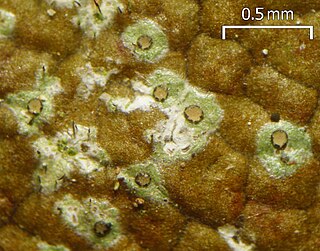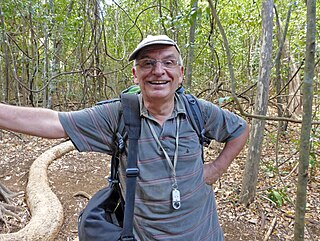
The Pertusariaceae are a family of lichen-forming fungi in the order Pertusariales.

Anisomeridium is a genus of lichens in the family Monoblastiaceae. The type species was originally named Arthopyrenia xylogena by Swiss botanist Johannes Müller Argoviensis in 1883; in 1928, Maurice Choisy defined the genus Anisomeridium, designating A. xylogena the type species.

Abrothallus is a genus of lichenicolous fungi. It is the only genus in the monotypic family Abrothallaceae, which itself is the sole taxon in the order Abrothallales.
Ferraroa is a single-species genus in the family Gomphillaceae. It is a monotypic genus, containing the single species Ferraroa hyalina, a foliicolous (leaf-dwelling) lichen. This species was originally described by Robert Lücking in 1997 as Gyalideopsis hyalina. The type specimen was collected from leaves of Inga oerstediana in Costa Rica. Lücking, Emmanuël Sérusiaux, and Antonín Vězda transferred the taxon to the newly circumscribed genus Ferraroa in 2005 after molecular phylogenetic analysis showed it to belong to a unique lineage. The generic name Ferraroa honours Argentinian lichenologist Lidia Itatí Ferraro, "for her many contributions to lichenology in southern South America, and to our knowledge of Gomphillaceae".
Gyalectidium is a genus of lichen-forming fungi in the family Gomphillaceae. A 2020 estimates placed 52 species in the genus. The genus was circumscribed by Swiss lichenologist Johannes Müller Argoviensis in 1881. He included 3 species: G. xantholeucum, G. dispersum, and G. filicinum; the last of these is now the type species of the genus.

Tricharia is a genus of lichens in the family Gomphillaceae. It has an estimated 30 species.
André Aptroot is a Dutch mycologist and lichenologist.
Rolf Santesson (1916–2013) was a Swedish lichenologist and university lecturer. He was awarded the Acharius Medal in 1992 for his lifetime contributions to lichenology.
Thomas Hawkes Nash III is an American lichenologist. His research is about the biology and ecology of lichens, and the effects of air pollution on plants and lichens. He is known as an authority on the family Parmeliaceae. During his long career at the Arizona State University, he helped develop the lichen herbarium into a world-class collection with over 100,000 specimens representing more than 5000 species. In 2010, the year of his retirement, he was awarded the Acharius Medal for lifetime achievements in lichenology, and the following year had a Festschrift published in his honor.
Antonín (Toni) Vězda was a Czech lichenologist. After completing a university education that was postponed by World War II, Vězda taught botany at the Czech University of Life Sciences. In 1958, he was dismissed from his university position as a result of the restrictions placed on academic freedoms by the communist regime in power. He eventually was hired as a lichen researcher by the Czechoslovak Academy of Sciences, who allowed him to work from his apartment, which served also as an office and herbarium.
Corticifraga is a genus of lichenicolous fungi in the family Gomphillaceae. The genus was circumscribed by David Leslie Hawksworth and Rolf Santesson in 1990, with Corticifraga peltigerae assigned as the type species.
Rolueckia is a lichen genus in the family Gomphillaceae. It was circumscribed in 2018 to contain a single species, the lichenicolous fungus Taitaia aurea. This species is characterized by aggregated ascomata with yellow margins, and salmon-red discs that originate from a single base. It is found in tropical montane forests in Kenya, where it grows on thalli of the lichen Crocodia.

Emmanuël Sérusiaux is a Belgian lichenologist. His career, spanning more than four decades, has combined both lichenology research and political aspects of nature conservation. He spent several periods working as a researcher at the National Fund for Scientific Research and the University of Liège, the latter in which he accepted a faculty position as professor and head of the Plant Taxonomy and Conservation Biology unit. Sérusiaux also served for three non-consecutive appointments as Deputy Chief of Staff in the Government of Wallonia. He retired from both his academic and political positions in 2019.

Strigulaceae is a family of lichen-forming fungi, one of two families in the order Strigulales. Recent (2020) molecular analysis of the type genus, Strigula, has led to a reallocation of the foliicolous species into six genera that correspond to well-delimited clades with diagnostic phenotype features.

Coenogonium is a genus of crustose lichens in the monotypic family Coenogoniaceae. It has about 90 species. Most species are leaf-dwelling or grow on bark, although a few are known to grow on rocks under certain conditions, and some are restricted to growth on termite nests. The genus was circumscribed in 1820 by German naturalist Christian Gottfried Ehrenberg.

Gyalideopsis buckii is a species of bark-dwelling lichen in the family Gomphillaceae. It is found in the United States.
Arthotheliopsis serusiauxii is a species of leaf-dwelling lichen in the family Gomphillaceae. It was first formally described as a new species in 1997 by Robert Lücking, as a member of genus Echinoplaca. The type specimen was collected in Costa Rica, growing on the leaves of a dicotyledon. The specific epithet honours Belgian lichenologist Emmanuël Sérusiaux. In 2005, Lücking, Sérusiaux, and Antonín Vězda transferred it to genus Arthotheliopsis after a molecular analysis of the Gomphillaceae helped to clarify the phylogenetic relationships in the family.
Henricus (Harrie) Johannes Maria Sipman is a Dutch lichenologist. He specialises in tropical and subtropical lichens, and has authored or co-authored more than 250 scientific publications. He was the curator of the lichen herbarium at the Berlin Botanical Garden and Botanical Museum from 1983 until his retirement in 2010.
A plasticolous lichenized fungi is a lichen which grows on plastic surfaces. This behaviour was first observed in 1994 when foliicolous lichens were found growing on plastic tape but they have since been observed growing on artificial plastic leaves, plastic signs and nylon nets.







